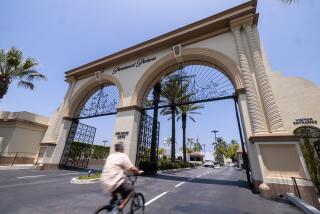Drawing a Niche in Cartoons : Television: After pouring $26 million into Zodiac Entertainment, a British broadcasting concern now has two series on the air.
British broadcasting concern Central Independent Television PLC went on a shopping trip to the United States five years ago, hoping to buy a television production company. But Central didn’t find anything to its liking, so in 1989 it started Zodiac Entertainment in Studio City, a producer of animated children’s shows.
It was a risky move. Animated television production has in the past several years become the province of major studios such as Walt Disney Co. and Warner Bros., while small, independent producers have been struggling. The business requires large capital investments, and profits are often delayed for many years until revenues from foreign sales begin flowing in.
Three years later Central has poured more than $26 million into Zodiac and it has two cartoon series on the air. But Zodiac has yet to produce a profit. Kevin Morrison, Zodiac’s managing director, formerly a Central programming executive, expects Zodiac to take in about $10 million in revenue this year, and said that further cash infusions from the parent company won’t be needed. But he acknowledged that achieving profitability in television production is difficult.
“You have to be, financially, quite patient in this business,” he said.
For independents, the odds of survival are long. Even large children’s animation independents such as Hanna-Barbera, now owned by Turner Broadcasting System, Marvel Productions and DIC Enterprises have felt some pain as the major studios increasingly flex their muscles.
“It’s extremely difficult because the big guys are just dominating it,” said Ken Spears, vice president of Ruby-Spears Productions, an independent animated programming producer.
Still, Morrison sees some virtues in children’s programming. American-made cartoons sell well abroad because foreign languages can be easily substituted for English without the shows appearing dubbed.
Kids’ shows also have long shelf lives. The “Flintstones,” for instance, has been around for decades but children today are seeing their first episodes.
Morrison--along with Peter Keefe and Brian Lacey, two animation veterans who helped form Zodiac--saw another way to help Zodiac become established. Its first program, “Widget,” has a socially conscious, environmental theme that helps television stations meet government standards for educational content in children’s programming.
“Widget,” now in its third season in syndication, is about a purple alien and two young earth boys he befriends, who travel the world solving ecological problems. The show was shown on weekends in the fall of 1990, and by the following year its ratings were good enough that it was expanded to five days a week. It now appears in 80% of the U.S. television market and in about 90 countries.
Last year Zodiac started its second series, “Mr. Bogus,” a more traditional cat-and-mouse-type cartoon based on a character developed by a Belgian group. “Mr. Bogus,” now on Sundays, was the highest-rated weekly syndicated kids’ show in the country during the Neilsen ratings “sweeps” in May. Zodiac plans on producing it for a five-day-a-week run next season.
Every animated production company is hoping for the next big hit, Spears said, but independents have an especially tough time getting their shows noticed because they’re frequently relegated to poor time slots.
“If the advertising dollars are not forthcoming,” he said, “it’s almost animation suicide.”
Jeff Segal, president of MCA’s Universal Cartoon Studios, said “even a major finds it a tempestuous and tricky business to be in.” But he gives Zodiac credit for being one of the first to offer a kids’ show with an environmental theme and for managing to establish a track record with independent broadcasters. “They’ve sort of found a little window of opportunity,” he said.
Keefe, Zodiac’s director of production and creative development, said Zodiac has no immediate goal of being anything more than a “boutique” production shop. The company has 15 employees, including five in New York, where Lacey runs the marketing operations. Calico Entertainment in Northridge does Zodiac’s design and production work, and the painting and filming is done in South Korea.
Zodiac is now working on its third series, “Twinkle the Dream Being,” for next fall. It’s also developing a game show, and has begun striking licensing deals for toys and other merchandise based on its characters.
Meanwhile, Zodiac has the advantage of a strong parent company. Central holds the television franchise for the central region of Britain, and is one of that nation’s largest providers of independent television shows.
In the six months that ended June 30, Central’s earnings surged to 9.3 million pounds (equal to about $14 million at current exchange rates) from 2.1 million pounds in profit a year before. Its revenue rose 14% to 159 million pounds.
Whether Zodiac turns into a money-maker for Central remains to be seen. But Morrison said it’s now apparent that Central chose the less risky way into the U.S. market when it decided against an acquisition.
Other British broadcasting companies that acquired U.S. production companies during the past few years are now in trouble.
TVS Entertainment bought MTM Entertainment, the producer of “Hill Street Blues” and “Lou Grant,” in 1988 for $320 million. The acquisition proved disastrous, and financially ailing TVS is now entertaining buyout offers.
Similarly, now-troubled Thames Television was criticized when it acquired Reeves (“Covington Cross”) Entertainment in 1990 for a hefty $90 million. Central had earlier passed on an opportunity to acquire Reeves.
More to Read
The biggest entertainment stories
Get our big stories about Hollywood, film, television, music, arts, culture and more right in your inbox as soon as they publish.
You may occasionally receive promotional content from the Los Angeles Times.











